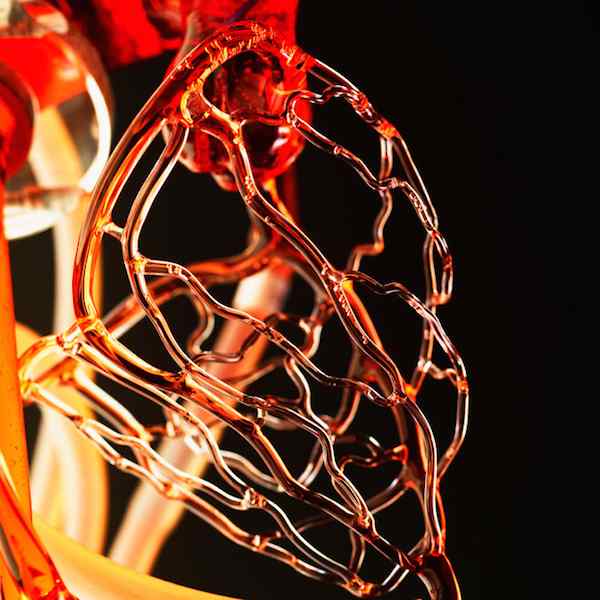
[Image above] Glassware made by Farlow’s Scientific Glassblowing mimics human vasculature to toe the line between art and science. Credit: Wired
Why is there often a line drawn between art and science?
Bachelor’s degrees. Museums. Sides of the brain. Are these barriers real, or simply cultural categorizations?
Even here at ACerS headquarters, our office is separated into two distinct sides—the “art side” and the “science side.”
But the line between art and science, if there is one, is blurry at best. And the ideas, objects, and notions that live in that blurry zone comprise a group that is interesting, awesome, unique, beautiful, revolutionary, and just plain cool.
Ceramics and glass, perhaps more than any other material, have a happy home in the blurry area between art and science. And perhaps smack in the center of that group is scientific glassblowing—part science, part art, and all awesome.
Glass not only finds itself on both sides of the science/art fence, but it is completely tangled up in the history of science—glass tubes, vessels, beakers, flasks, dishes, and other glass goods were integral to the earliest and most fundamental scientific discoveries. Isaac Newton’s prism. Robert Koch’s culture dishes. Nikola Tesla’s/Thomas Edison’s lightbulb. Dmitri Mendeleev’s flasks and beakers.
It used to be that many of the glass goods of science were brought to life by the lungs of a highly skilled glassblower. Most labs actually once employed their own in-house glassblower to fashion the glassware they needed for experiments. Like this dude:

A glassblower creating custom scientific glassware at the University of Iowa in 1938. Credit: Iowa Digital Library; Flickr CC BY-NC 2.0
While a large proportion of scientific glassware no longer needs lungs to find life, intricate and custom glassware still requires the skill of a custom craftsman.
Farlow’s Scientific Glassblowing (Grass Valley, Calif.) is one of the relatively few remaining companies that offers custom blown scientific glassware. The glass experts there produce custom blown glass molds, tubes, and equipment, but one of their most impressive and unusual products is their custom created and anatomically correct models of the human body. Check out this short video to see the glass gods at Farlow’s in action.
Credit: CNN; YouTube
When you’re done, head over to Schott’s blog to read a recent post by scientific glassblower Mike Souza about the history, status, and value of the discipline today.
Need additional reads? For an in-depth look at the history of glassblowing, head over to the American Scientific Glassblowers Society website for a comprehensive past.
And if you’re as fascinated by seeing scientific glassblowers in action as I am, check out some more amazing videos by Ross North, scientific glassblower at Canada’s ProScience Glass Shop.
While we’re talking glassblowing (and since you haven’t gotten lost in the ridiculous amount of links I put in this post—congratulations for staying focused!), check out this interesting six-minute documentary about a professional neon sign maker. Although it’s a bit more art than science, we know that’s a fuzzy distinction at best.

